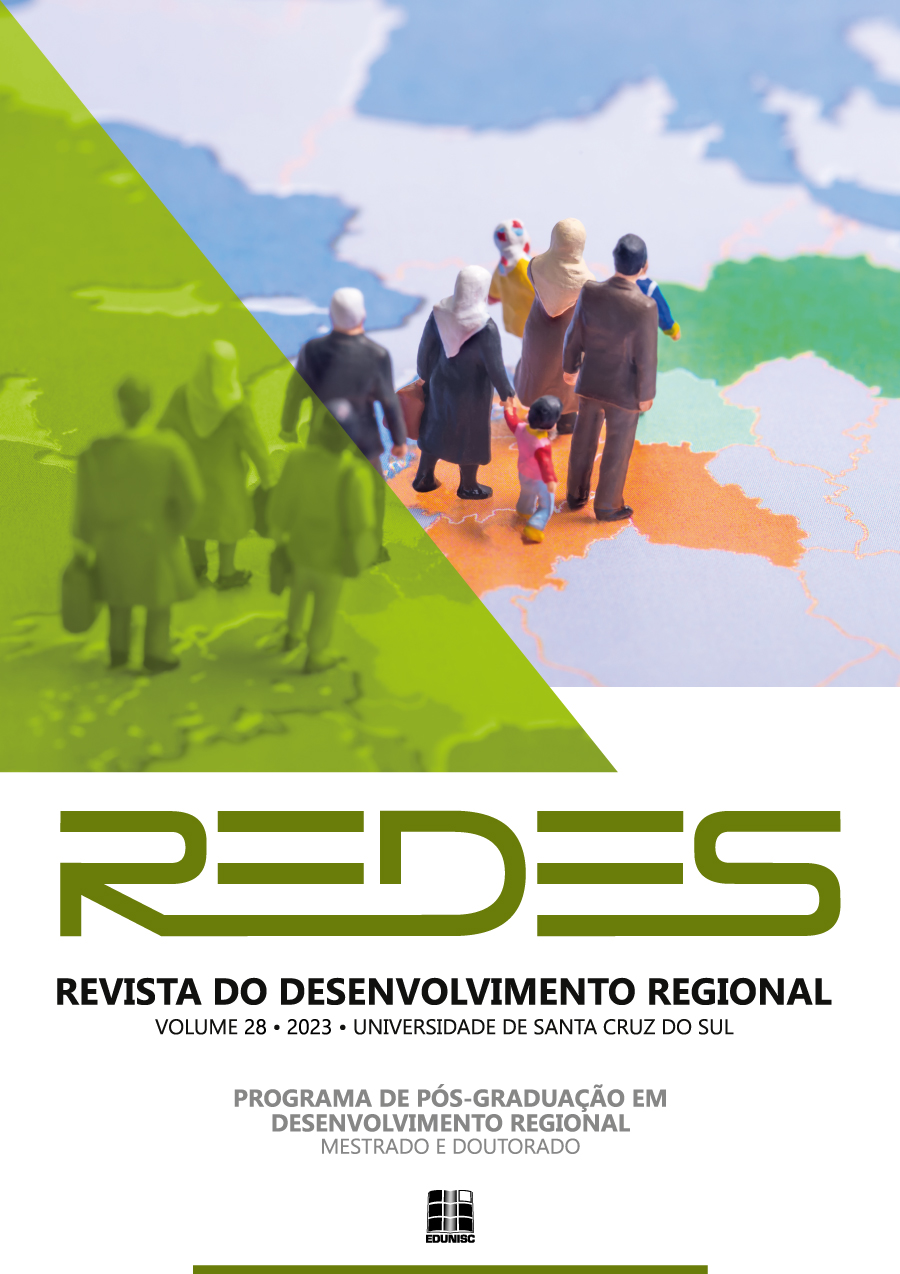The ramifications of urban planning through the applicability of Taxable Instruments in Ivaiporã/Paraná/Brazil
DOI:
https://doi.org/10.17058/redes.v28i1.18443Keywords:
Planning, Urban, Methodology, Assessment, InstrumentsAbstract
Space and the Brazilian city were planned and conceived according to the ideals of capitalist logic, generating socio-spatial segregation and inequalities regarding access and permanence with dignity in cities. The Municipal Master Plan, as the main instrument in the field of Urban Planning, has been used for territorial organization in Brazilian cities of different sizes. In the state of Paraná, a large number of municipalities with small towns have presented Master Plans. Thus, the question is: have small cities prepared Master Plans with applicable instruments, in particular, the taxable ones? The objective is to discuss urban planning and the master plan in small cities, focusing on the instruments and their applicability, based on the city of Ivaiporã, located in the central portion of the state. Therefore, the methodology used aimed to evaluate the applicability of the tax instruments in the Municipal Master Plan of Ivaiporã (2008, 2010), based on the methodology developed by the Evaluation and Training Network for the Implementation of Participatory Master Plans - PDP NETWORK (SANTOS JUNIOR, 2011). As well as a bibliographic review concerning the research problem was carried out. It is concluded that the PDM of Ivaiporã has its positive points, but it lacks the necessary aspects for it to be in fact applicable and to transform an urban structure in the long term, since the Municipal Laws of its Municipal Master Plan, and of the Tax Code, have advanced in the sense of its elaboration and of certain actions aimed at urban development, however, very lacking for it to be possible to state that this applicability occurs in a full way.
Downloads
References
ANTONELLO, I. T. Potencialidade do Planejamento Participativo no Brasil. Soc. & Nat. Uberlândia, v.25, p.239-254, maio/ago, 2013.
ANTONELLO, I. T.; VEIGA, L.A política pública habitacional brasileira: cidades excludentes, negação do direito de cidadania In: Desafios e Tendencias do Estado de Direito na Democracia no Século XXI.1 ed.Coimbra: JUS XXI & DEE Internaciel Publishinglda, 2022, v.6, p. 37-52.
ANTONELLO, I. T.; VEIGA, L.; BERTINI, I. T.Cidade excludente: O Ordenamento do território urbano atrelado a Polícia Habitacional em Londrin/PR In: Encontro Nacional da Associação Nacional de Pós- Graduação e Pesquisa em Planejamento Urbano e Regional, Anais [...] 2022, Blumenau/SC.
ALVES, Flamarion Dutra. Considerações sobre métodos e técnicas em geografia humana. Revista Dialogus, Ribeirão Preto, v. 4, n. 1, p. 227-241, 2008.
BATTINI, L. M.; ANTONELLO, I. T. A aplicabilidade do parcelamento, edificação ou utilização compulsórios (PEUC) no município de Londrina In: PLANEJAMENTO TERRITORIAL E DESENVOLVIMENTO REGIONAL NOS DIFERENTES ESPAÇOS E CONTEXTOS: CONSENSOS, POSSIBILIDADES E CONTROVÉRSIAS. 1 ed. Santa Maria/RS: Arco Editores, 2021, v.1, p. 109-120.
BRASIL. Estatuto da Cidade – Lei n. 10.257, de 10 de julho de 2001. Regulamenta os artigos 182 e 183 da Constituição, Brasília, 2001
BRASIL. Constituição da República Federativa do Brasil de 1998. Brasília, 1988
INSTITUTO BRASILEIRO DE GEOGRAFIA E ESTATÍSTICA – IBGE. Regiões de Influência das Cidades – REGIC. 2018. Disponível em: https://www.ibge.gov.br/geociencias/cartas-e-mapas/redes-geograficas/15798-regioes-de-influencia-das-cidades.html?=&t=o-que-e. Acesso em 20 de jan. 2023.
DENEZ, Cleiton Costa. A DINÂMICA POPULACIONAL NA REGIÃO DE IVAIPORÃ/PR (1970-2010). Revista geografar (UFPR), v. 6, p. 130-150, 2011.
IVAIPORÃ. Lei Municipal n° 1.517/2008. DISPÕE SOBRE O PLANO DIRETOR MUNICIPAL DE IVAIPORÃ-PR E DÁ OUTRAS PROVIDÊNCIAS. Ivaiporã, 2008.
IVAIPORÃ. Lei Municipal n° 1.890/2010. Dispõe sobre o Sistema Tributário do Município e dá outras providências. Ivaiporã, 2010.
HARVEY, David. Cidades Rebeldes: O Direito à Cidade e à Revolução Urbana; tradução Jeferson Camargo. São Paulo: Martins, 2014.
MARQUES DA Costa, Eduarda; ANTONELLO, Ideni, T. Urban Planning and Residential Segregation in Brazil-The Failure of the -Special Zone of Social Interest- Instrument in Londrina City (PR). Sustainability , v.13, p.13285 - 13304, 2021
MARICATO, Ermínia. Brasil, cidades: alternativas para a crise urbana. Petrópolis: Editora Vozes, 2013.
MARICATO, Ermínia. O impasse da política urbana no Brasil. Petrópolis: Editora Vozes, 2017.
MARICATO, Ermínia; ROYER, Luciana. A política urbana e de habitação. In: MARINGONi, G.; MEDEIROS, J. (Org.). Cinco mil dias. São Paulo: Boitempo, 2017. p. 147-157.
OLIVEIRA, A. P. S.; ANTONELLO, I. T.A utopia de transformação socioterritorial pela luz que irradia da participação popular: Abordagens Latino- Americanas de planejamento urbano. In: Encontro Nacional da Associação Nacional de Pós- Graduação e Pesquisa em Planejamento Urbano e Regional. Anais [...]. Blumenau/SC, 2022.
PARANÁ. Decreto Estadual nº 2581/2004. O ESTADO DO PARANÁ SOMENTE FIRMARÁ CONVÊNIOS DE FINANCIAMENTO DE OBRAS DE INFRA-ESTRUTURA E SERVIÇOS COM MUNICÍPIOS. Curitiba, 2004.
REGO, Renato Leão et al. Ideias clássicas, aspirações modernas: traçado das cidades novas do norte do Paraná. Revista de Morfologia Urbana, v. 3, n. 1, p. 19-29, 2015.
ROLNICK, Raquel. Guerra dos Lugares: a colonização da terra e da moradia na era
das finanças. 2.ed. São Paulo: Editora Boitempo, 2019, 424 p.
ROSANELI, Alessandro Filla. Cidades novas da fronteira do café: história e morfologia urbana das cidades fundadas por companhias imobiliárias no norte do Paraná. 2009. Tese de Doutorado. Universidade de São Paulo, São Paulo, 2009.
SANTOS JUNIOR, Orlando Alves dos; et al. Os diretores municipais pós-estatuto da cidade: balanço crítico e perspectivas. Rio de Janeiro: Letra Capital: Observatório das Cidades: IPPUR/UFUJ, 2011.
SOUZA, Marcelo José Lopes. Mudar a cidade: uma introdução crítica ao planejamento e à gestão urbanos. Rio de Janeiro: Bertrand Brasil, 2016.
SZMRECSANYI, Maria Irene. O modelo das cidades-jardins no norte do novo Paraná. Revista do Programa de Pós-Graduação em Arquitetura e Urbanismo da FAUUSP, n. 8, p. 178-197, 2000.



